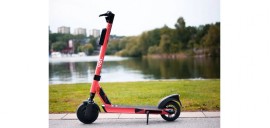BEAST met with Peter Kürpick, Executive Vice President and Chief Platform Officer of HERE, to discuss the revolution occurring in the mobility sector and the development of smarter cities. The company formerly owned by Nokia made the headlines when it was bought by an unusual consortium of BMW, Audi and Mercedes-Benz, and has since then, been very active, collecting data with the aim of improving quality of life and preserving the environment.
You’re a major player in the fast-changing mobility sector, how can HERE’s mission be defined?
The world is about to go through a massive change that will impact the way we live and move. Of course, I am talking about the rise of autonomous machines across transportation, logistics, retail and healthcare and other industries. It’s not happening overnight, but it will happen and we need to make sure that it will be a world in which we want to live in. Cloud-based mapping and location services are going to play a hugely important role in this respect, and that’s where we come in. We can use location data to help make our roads safer and less congested, help logistics networks to function more efficiently, and to help our fast-growing cities offer residents a better quality of life and cleaner air to breathe.
According to you, what are the main benefits of autonomous mobility?
For me, safety is the biggest one. 1.3 million people die in road traffic accidents every year, mostly due to human error. It’s tragic. We can make a big dent in that number, though. Even today, long before self-driving cars arrive, we can make a difference. For example, this year we’re launching new services that will help drivers get a better understanding of what is happening on the road ahead of them. These services are based on real-time information we gather from the vehicle sensors of large populations of Audi, BMW and Mercedes-Benz cars on the road. If the car detects something happening on the road such as slowing traffic, an accident or a lane temporarily out of use, our cloud is automatically notified. We then process that data and send it out to other cars approaching the same area cautioning them to slow down or take a different route. We’re very excited about the prospects of services like this because they will also help cars drive more intelligently in general - and that means less congestion and emissions. And of course we welcome other car companies to participate too. The more cars that share their data, the greater the benefits for everyone.
It seems that traditional automotive actors are catching up lost time thanks to HERE... How?
The issue the biggest car brands face is not so much technological as they are well along with their plans to bring autonomous technologies to the market. It’s probably more to be with mindshare and the perception that technology players are ahead of them in this game. I think when we actually start to see conditional and highly automated driving features become more widespread in the market, many of the incumbents will be in a strong position. As we’ve seen, many are also investing in new ventures that will ensure they’re going to be able to fulfil the mobility needs of a new generation of customers – even those who don’t wish to own a car outright, but who’d rather use car-sharing and rental options.
What are the hidden mobility trends you keep a close eye on? Why?
Much attention is placed on what a world of self-driving cars will look like. But there are some quite impactful things we can do today to make life better for people on the road. One area which is underserved is parking. It’s a perennial problem. In some areas of Berlin, where I’m based, a third of the time people spend in the car is actually during the process of trying to find a parking space on the
street. That’s creating a lot of annoyance for the driver, not to mention noise and pollution. We’re looking into how we can address this problem using vehicle data - that is, knowing when a space becomes vacant and communicating that to a driver who needs one. It’s actually a complex challenge but we’re on it.
Luxembourg is one of most congested countries in Europe with more than 180,000 people crossing the boarders to go to work every single day. How important is the country for autonomous driving manufacturers and their partners, notably HERE?
As a small country, but one which faces congestion, Luxembourg highlights the requirement that connected driver services work across borders. Interoperability is paramount: when you cross from Belgium into Luxembourg or vice versa, you still want your car to perform in the same way. Our goal is very much to ensure that services can be scaled. That’s the benefit of using the cloud and mobile networks versus other V2X technologies - our cloud can be easily switched on to cover large geographies.
How would you describe the city of the future? How important is data when it comes to building it? Who needs to be involved in the creation of such cities?
These are questions that fascinate us. But they aren’t of course easy to answer. There are so many factors to consider. How does a city function in a world of autonomous machines and artificially intelligent robotics? Are there city layouts that are better equipped for this future than others? What are the implications of the on-demand economy and new work practices on city design? What demands will other societal trends, such as population growth and ageing, place on urban planners? I believe there is certainly a role for location data to play in helping answer these questions. I also believe that we can apply location data to ensure we build better-functioning cities and transportation networks in the future. After all, in the coming decades many new cities will emerge.
This article has already been published in BEAST Magazine #7 / www.beastmagazine.lu










